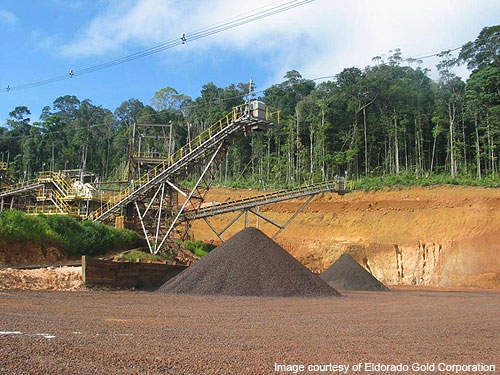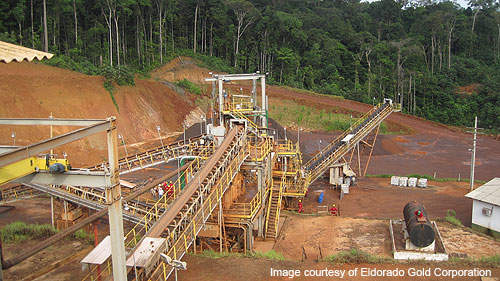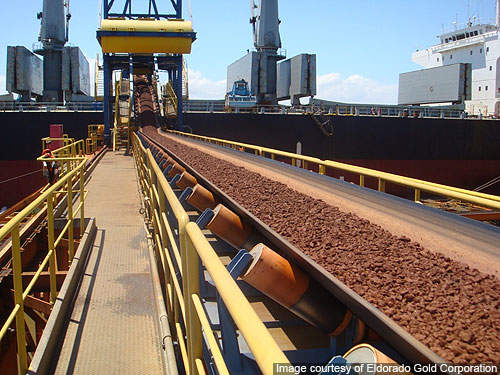The Vila Nova iron ore mine is located 175km west of Macapa in the state of Amapa, Brazil. It covers about 1,475ha. Eldorado Gold Corporation (EGC) is the owner and operator of the mine. Mineracao Amapari held a 25% stake in the mine, but sold it to EGC in August 2009. EGC, however, owns the mine indirectly through its subsidiary Unamgen Mineracao e Metalurgia.
Development of the mine was completed in 2009 at a cost of $39m. The mine and processing plant were successfully commissioned in the second quarter of 2009. Production began in the third quarter of 2010.
Mineralisation
The mineralisation comprises a steeply dipping banded iron formation (BIF) curving north to north-east with high grade massive hematite ore in the core and low grade itabirite on either side.
The BIF comprises hematite and itabirites pieces with high iron ore deposits and low silica, alumina and phosphorous contaminants.
EGC identified the mineral deposits during an aeromagnetic survey conducted in the Amapa region.
Geology and reserves
The project site is located in an area identified as being of Paleoproterozoic age and consists of metasedimentary units with mafic metavolcanic rocks at the base.
The mine contains 9.2Mt of proven and probable reserves graded at 61% Fe. Inferred reserves are estimated at 2Mt graded at 61.2% Fe.
Measured and indicated reserves are estimated at approximately 10Mt graded at 61.6% Fe.
Production
The mine is designed for a production capacity of 900,000t of run of mine (ROM) ore per annum, with an operational life span of nine years.
The first vessel loaded with 45,000t of lump ore graded at 63% Fe was delivered to China in November 2010. The delivery was made as part of the 2010 trail mining plan, which demonstrates the ore quality, plant throughput and transportation logistics. EGC intends to deliver an additional 90,000t of iron ore under this plan.
Open-pit mining
The iron ore deposits are being extracted using conventional open-pit excavation methods including drilling, exploring, blasting, loading and hauling.
Two operational pits (the Lagos final pit and the Bacabal final pit) were dug to derive the reserves. Drilling was executed by wireline technique with H-size equipment using three drill rigs.
The Lagos pit hosts 551,000t of hard ore graded at 61.1% Fe and 260,000t of medium ore graded at 61.8% Fe. The Bacabal pit comprises 5.2Mt of hard ore graded at 61.5% Fe, 2.43Mt of medium hard ore graded at 59.8% Fe and 827,000t of soft ore graded at 61.7% Fe.
The berm width and road width of the open-pit are 5m and 10m respectively. The bench height is 10m. The face angle and overall slope are 60° and 35° respectively. Hydraulic excavators and highway trucks with traditional rock boxes are used in the mining.
Mining and processing
The mine site has maintenance shops, accommodation, changing rooms, a cafeteria, office buildings, crushing and screening facilities and a tailing dam.
Lump ore and sinter feed products extracted from the open pit are transmitted to the processing plant for further processing. The plant features a primary crusher, a secondary crusher, a primary screen, a secondary screen and a gravity separation system.
The plant breaks down the BIF contaminants into small particles and produces high-graded hematite and itabirite concentrates through a gravity separation system. The high-graded hematite and itabirites are suitable for producing top quality iron ore pellets.
Transportation and handling
Lump ore and sinter fines produced at the mine will be transferred to the Santana Port by 35t conventional highway trucks. The port is located at a distance of approximately 180km from the site and is accessible by road along the partially paved BR 210 and BR 156 federal highways.
The Santana Port features a ship loading facility for transportation of the mine’s products to a number of countries. The port also features a screening plant for processing lump ore.










